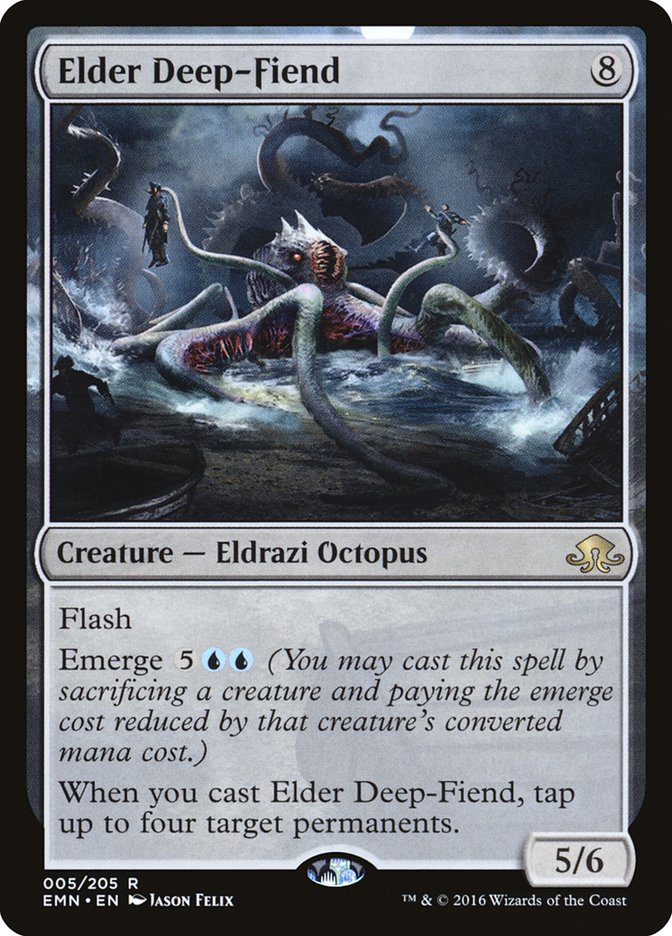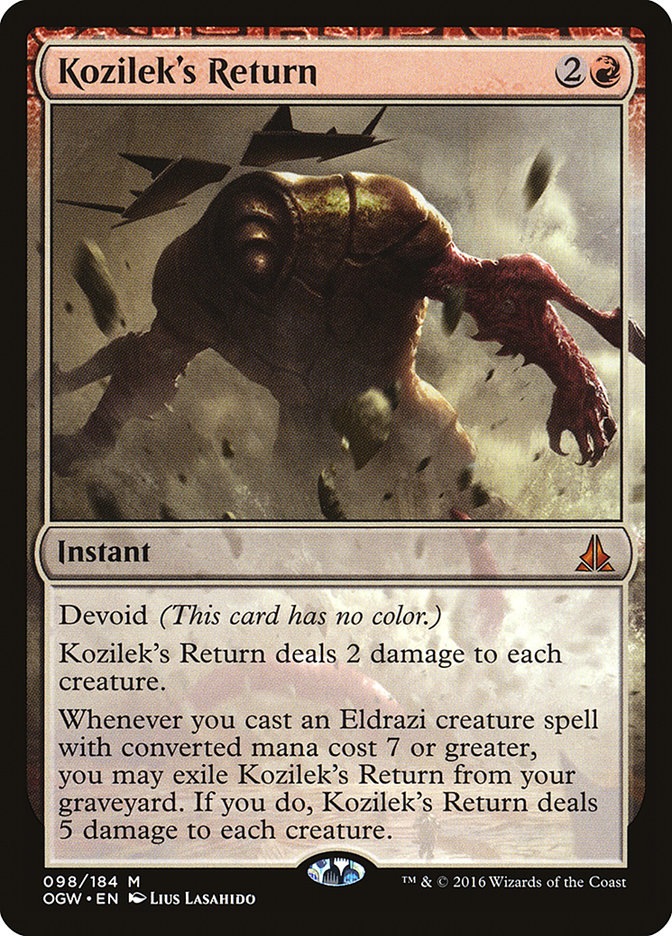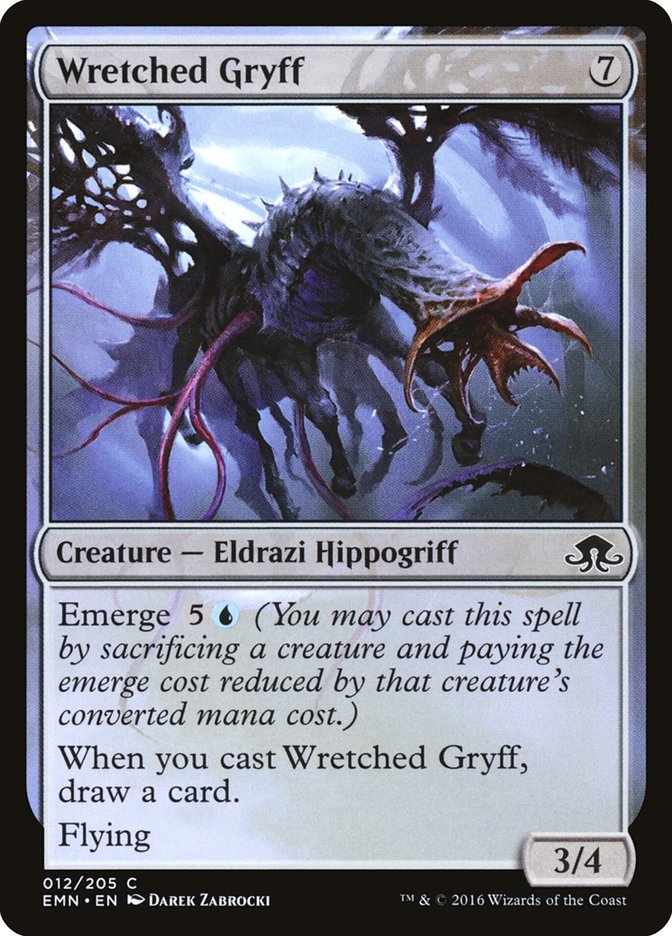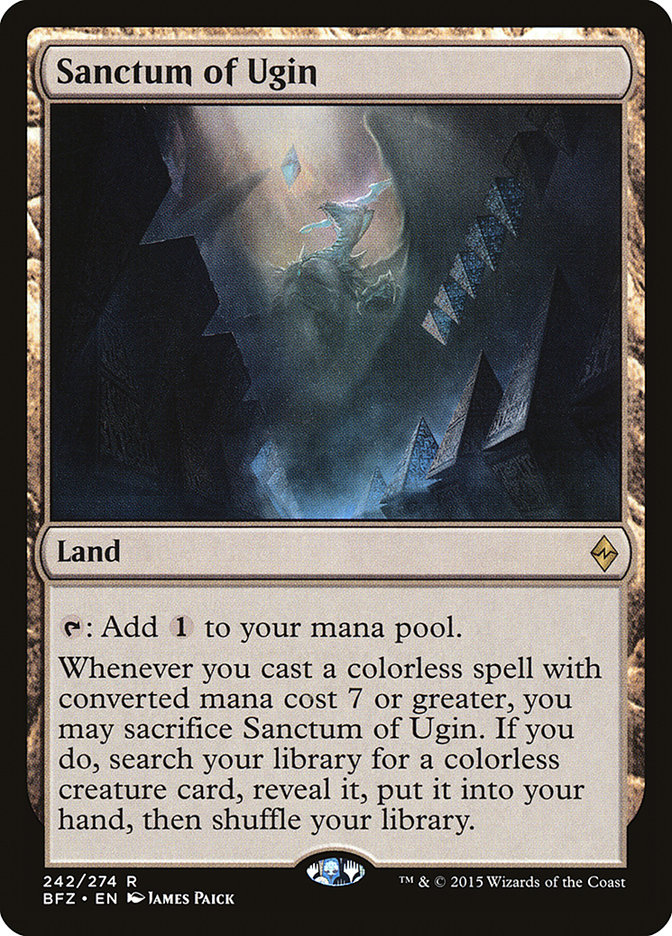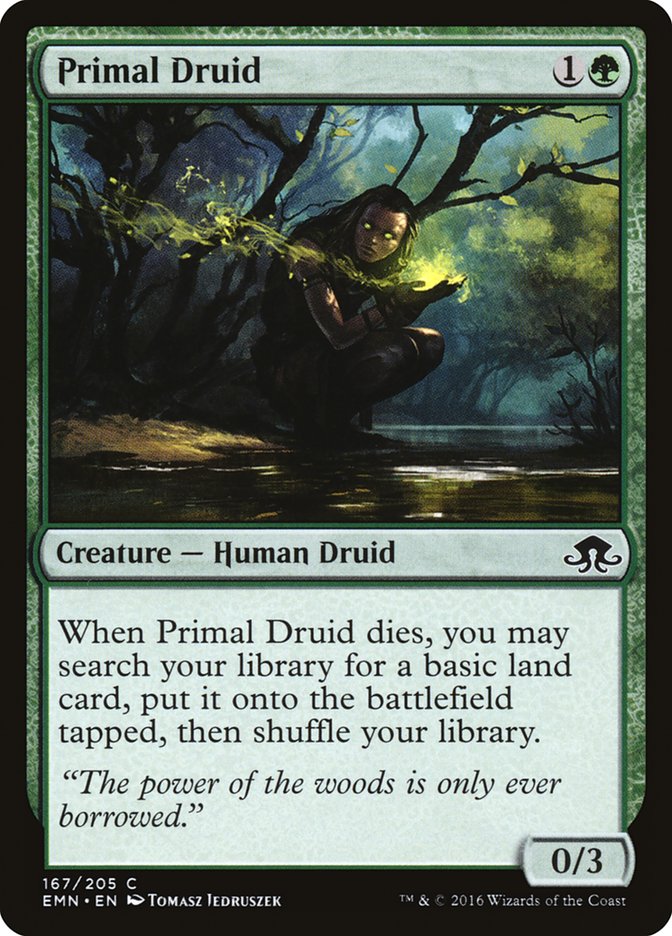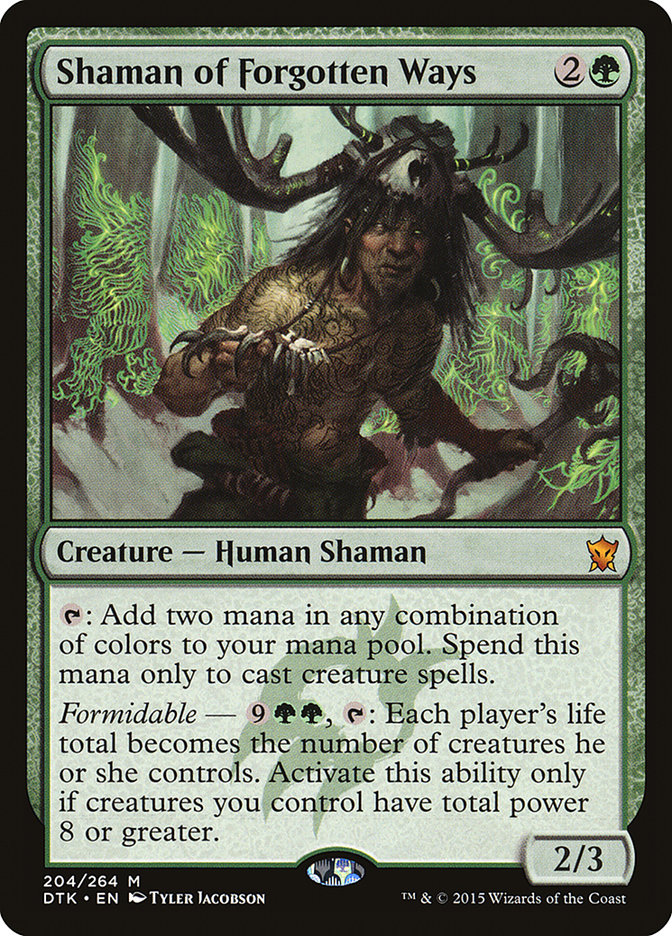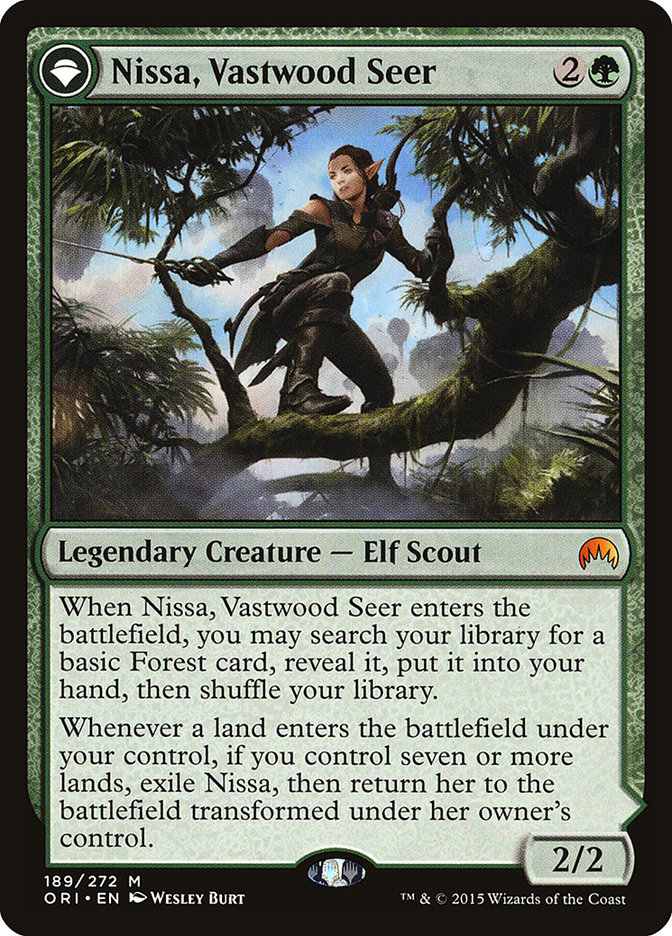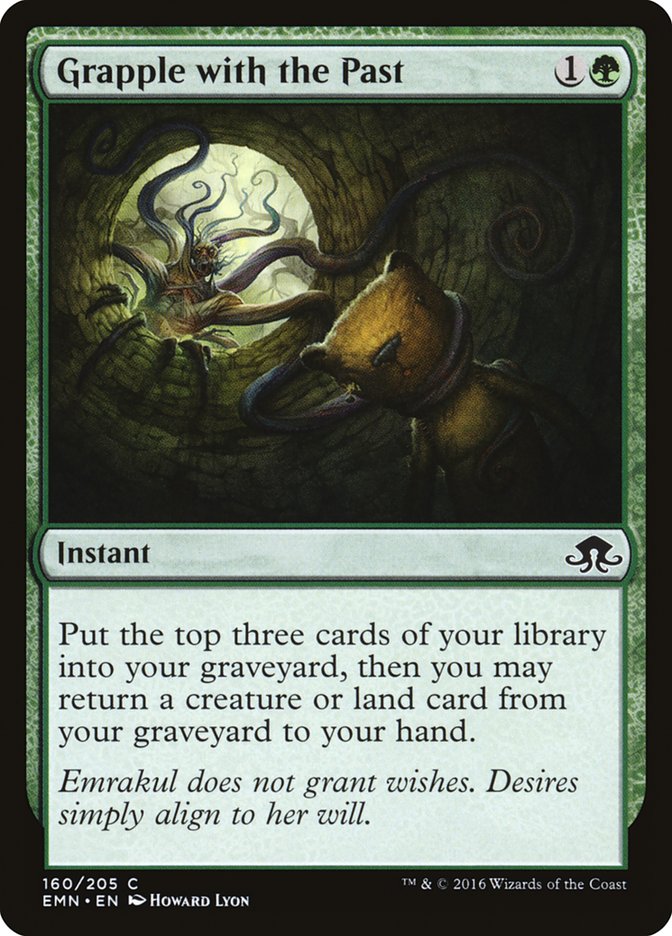Going into Pro Tour Eldritch Moon, I was fairly content with how my year of Magic had gone. I had made the Top 8 of Pro Tour Oath of the Gatewatch, built the deck that Seth Manfield piloted to the Top 8 of Pro Tour Shadows over Innistrad, and secured Gold status in the Pro Players’ Club. But after recently getting laid off from my job at Activision and sitting at 35 Pro Points, I decided to make a push for Platinum status with my newfound abundance of free time. A 12-4 record would yield the 15 Pro Points I needed to reach Platinum, and while it felt like a lofty goal, I was confident that my hard work and dedication could carry me across the finish line.
After many hours of testing with Team East West Bowl, I settled on the following:
Creatures (24)
- 3 Shaman of Forgotten Ways
- 4 Jace, Vryn's Prodigy
- 1 Nissa, Vastwood Seer
- 4 Matter Reshaper
- 4 Wretched Gryff
- 3 Elder Deep-Fiend
- 1 Lashweed Lurker
- 4 Primal Druid
Lands (24)
Spells (12)

Temur Emerge was the result of a few ideas from me and GAM Podcast co-host Michael Majors. Upon the spoiling of the card Elder Deep-Fiend, we immediately recognized it as one of the most powerful cards in the set and its powerful synergy with Kozilek’s Return. The ability to essentially Time Walk your opponent, trigger Kozilek’s Return, and provide a strong clock with one card while being immune to most of the common removal in the format makes it a very appealing card to build around.
Kozilek’s Return’s trigger is hard to interact with in the graveyard, can’t be countered, can’t be prevented with Dromoka’s Command, and most importantly does not kill Elder Deep-Fiend. Initially we thought Elder Deep-Fiend was primarily going to be played during upkeeps to tap lands, but as we tested, its flexibility was the real draw to the card.
It serves a different role in every matchup. Against G/W Tokens it’s a planeswalker killer, tapping their creatures in the end step to push through to Gideon, Ally of Zendikar or Nissa, Voice of Zendikar. Against Bant Company it triggers the graveyard ability of Kozilek’s Return or ambushes an incoming Sylvan Advocate. Against traditional ramp decks, it shines brightest tapping their lands and keeping them from casting anything relevant.
With the fundamental base of Kozilek’s Return and Elder Deep-Fiend, we had to find other ways to trigger the backside of Kozilek’s Return. The other emerge options in blue were Vexing Scuttler, Drownyard Behemoth, and Wretched Gryff. Wretched Gryff stood out to me the most because it cost one less mana than Elder Deep-Fiend. That one mana can be the difference between life and death when playing against aggressive decks like Bant Company or White Humans. Then, when we branched into green, Lashweed Lurker became an easy silver bullet to include because you can tutor it up with Sanctum of Ugin and it can deal with any troublesome nonland permanent.
The next logical step was to find the best way to make emerging reliable and how to mitigate the resource loss when sacrificing a creature. Cost reduction has historically been a “broken” mechanic, but to essentially two-for-one yourself to cast something ahead of schedule is a high cost, so we had to figure out a way to stay ahead.
We wanted value. We wanted to make sure that all the cards we sacrificed to emerge left behind some form of card advantage. The key pieces here are Primal Druid, Matter Reshaper, Shaman of Forgotten Ways, and Nissa, Vastwood Seer. In life and in death they accomplish the same thing, casting your Eldrazi early by getting sacrificed or by accelerating your mana. Your opponent rarely wants to trade one for one on these creatures and they provide a solid road block before you establish your engine.
Primal Druid is the most important one because it allows you to emerge a Gryff on turn 4 and stay even on mana when sacrificing Sanctum of Ugin. Against White Humans, a sequence of Primal Druid into Kozilek’s Return or self-milling a Kozilek’s Return into Wretched Gryff to wipe their entire battlefield is game over.
Matter Reshaper is the most obvious piece of emerge fodder but I was most impressed with how it can just trade off immediately and get you ahead. You don’t need to cast your big emerge creatures early, and staying alive to hard-cast them later is a viable plan. We added Shaman of Forgotten Ways to our deck the day before the tournament and it was one of the best cards all weekend. I played a lot of emerge mirrors during the Pro Tour, and since there is low interactivity before turn 4, the Shaman was instrumental in netting me extra mana; surviving the front side of Kozilek’s Return is a big plus. The singleton Nissa, Vastwood Seer was a concession to Reflector Mage by adding a bit of diversity to our three-slot, but it proved itself to be a flexible threat in the late-game.
Now that we have the creature base of the deck, let’s get into the engine that makes all these moving parts tick. Jace, Vryn’s Prodigy; Grapple with the Past; Sanctum of Ugin; and Gather the Pack make everything mesh together. The main job of these cards is to get Kozilek’s Return into the graveyard and find or recur Elder Deep-Fiend. Jace can loot Kozilek’s Return away and the other two can incidentally mill it.
When playing the deck, most victories come down to one sequence when you turn the game and begin the Elder Deep-Fiend lock. You achieve this by clearing the battlefield with Kozilek’s Return and landing your first Elder Deep-Fiend. From there you can crack your Sanctum of Ugin or Gather the Pack for another, cast Grapple with the Past to get back the Sanctum you sacrificed or one you have already milled so that your second one can find the third.
Jace fuels this engine even more by flashing back Gather the Pack or Grapple with the Past to potentially find more pieces to continue the lock. It is common to emerge an Elder Deep-Fiend off of an Elder Deep-Fiend and then play or Flashback Grapple with the Past to get it back. While all of these land-tapping shenanigans go on, you are attacking them with your 5/6 creatures and possibly getting in with Lumbering Falls.
We settled on three Elder Deep-Fiend main because you never wanted a copy until you were going to initiate the lock. Wretched Gryff being a more reliable way to Flashback Kozilek’s Return made it a better choice for a full playset.
Some notable omissions from the main deck include Eldrazi Skyspawner, Foul Emissary, Pilgrim’s Eye, and Emrakul, the Promised End. The first three seem like excellent inclusions in any sort of emerge-style deck, but there is one simple reason for their absence: Liliana, the Last Hope.
While I was working on the Temur Emerge deck, my teammates on East West Bowl made an excellent B/G Delirium deck. Having a Liliana, the Last Hope kill your three-drop was so backbreaking that none of the creatures in my deck die to her +1 ability. If my teammates were able to come up with a good deck for her, I was certain other Pro teams were going to play her as well, so I cut all cards susceptible to her.
Emrakul, the Promised End is not completely omitted from my deck but I only gave her one slot in the sideboard. In the main I only have four types, making her cost a minimum of nine, and with the constant sacrificing of Sanctum of Ugin, getting to nine mana is an uphill battle. Post-sideboard I bring in more types and the Traverse the Ulvenwald to find her.
The other weakness of the deck is Kalitas, Traitor of Ghet. It can singlehandedly shut down your entire engine, as it will stop your Matter Reshapers and Primal Druids from triggering and it will also stop you from chain-casting Elder Deep-Fiends by sacrificing them to each other and returning them with Grapple with the Past.
We considered cards like Roast or Nahiri’s Wrath but chose not to include them because they were not creatures. Naturally drawing those spells is unlikely, flashing them back with Jace is difficult because he tends to die a lot in those matchups, and there are only five sources of red mana in the maindeck. I nearly registered Somberwald Stag in the sideboard but instead chose to go with strategy of hoping that I would never have to play against Kalitas.
This deck reminds me a lot of Affinity in Modern. It has a lot of unique pieces that work together, and each fills a very specific role, which is the deck’s primary weakness. You need to draw each of them in balanced proportions, or your deck will not function properly. You both set up your early turns accumulating mana and resources, and then when the time is right, you play your big spells and go for the kill. Sideboarding is also difficult with both these decks as you can only bring in a few cards per matchup, and diluting your maindeck by over-sideboarding can be a mistake.
The Other Fifteen
We made the sideboard with a lot of different things in mind: how to diversify versus Infinite Obliteration, how to grind out or go over the top of midrange opponents, how to surprise Pro Magic players, and how to stop aggro decks from getting under our big Kozilek’s Return triggers. The first three problems were solved together by adding in Emrakul, the Promised End and the cards that go along with her.
- Since our deck is good at self-mill, we first add more types and a more reliable source for sorcery other than Gather the Pack. Traverse the Ulvenwald was the obvious answer for finding Emrakul or adding sorcery to the graveyard. It is also finds the one Mountain in the deck for when you need Radiant Flames.
- Kiora, Master of the Depths has always been a card I’ve kept in mind and she works perfectly in our deck and sideboard plan. She can self-mill, provide value versus grindy decks, accelerate our mana by untapping lands or Shaman of the Forgotten Ways, and add the fifth type in our deck to reduce the cost of Emrakul.
- Thought-Knot Seer and Eldrazi Obligator provide a lot of surprise value because you can tutor them up with Sanctum of Ugin. Thought-Knot Seer can clear the way for Emrakul, and Eldrazi Obligator is a beating when you search for it in the end step after landing an Elder Deep-Fiend, tapping their squad and stealing their biggest creature.
- Ishkanah, Grafwidow is our Bant Company trump. It can buy you a ton of time and then you can emerge off it and Grapple with the Past it back to get a steady stream of Spiders.
- World Breaker is another large, sticky threat that can exile troublesome artifacts or enchantments.
- Radiant Flames and Noose Constrictor were concessions to White Humans and Spirits. Constrictor can be a big blocker and discard Kozilek’s Return at will. Radiant Flames is just a clean answer to any battlefield that gets too out of control.
How to Sideboard
Since this deck is so focused in one plan, I would usually sideboard by shaving down one or two copies of certain cards. It could also be correct to just not sideboard. If chaining Elder Deep-Fiend is the best avenue to victory, your maindeck is set up to do that. Multiple times in the tournament I did not change my deck at all for Game 2. The card that comes out the most is Gather the Pack to balance out your type count when you side in Traverse the Ulvenwald.
B/G Delirium
Out:
In:
Over the course of the Pro Tour’s Swiss rounds, I went 8-2 in Constructed, losing only to Brian Braun-Duin and Sam Pardee on the same 75 for B/G Delirium. Then I lost to Sam again in the Top 8. The B/G matchup ended up being the death of me; I think it is actually very close, but I always seemed to be on the losing end of it. Game 1 is favorable for you, but you have to be wary of getting hit by Emrakul. Post-sideboard, they have access to Kalitas, which is the single best card against this deck.
Bant Company
Out:
In:
This matchup is definitely in your favor Game 1, as they only have one pseudo-answer to your Kozilek’s Returns in Selfless Spirit. When playing the matchup, prioritize getting Kozilek’s Return in the graveyard by casting your self-mill cards. Reflector Mage can be a pretty big beating sometimes, but you want to maneuver the game to a turn where you have six mana so you can play a value creature into a Wretched Gryff to trigger Kozilek’s Return. Post-sideboard, the only card you have to be wary of is Summary Dismissal. Having one card counter all of your triggers puts you very far behind, so keep that in mind when playing.
B/W Control
Out:
In:
This matchup can vary depending on how many Kalitas they have access to in their deck. Against the Angel version I would say we are heavily favored, but against a deck like Lukas Blohon’s, which has three copies of Kalitas in the maindeck, we are not favored. We change our deck the most post-sideboard against B/W to become a more turbo Emrakul deck rather than a Time Walk aggro deck. Keep in mind that another out to Kalitas is to steal it with Obligator and then emerge off of it.
W/X Humans and U/W Spirits
Out:
In:
Although these decks did not end up being a big player in the tournament, we still brought some cards for it. Game 1 is definitely tough if you don’t draw any Kozilek’s Return or the red mana to cast it, but post-sideboard, Traverse the Ulvenwald gives you easier access to red mana and more sweepers.
Emrakul Ramp
Out:
In:
This is by far your easiest matchup, as their lack of early interaction makes them weak to a fast Elder Deep-Fiend chain. I would lump all three Emrakul decks in the Top 8 in this category. Post-sideboard, there is little they can do because traditional sweepers and counterspells are not effective against your gameplan. You often want to crack your Sanctum of Ugin for a Thought-Knot Seer as soon as you can to map out your best plan of attack.
B/U Zombies
Out:
In:
This is another excellent matchup, as they are poor at interacting with you and weak to Kozilek’s Return. I would not change the configuration of your deck for this matchup.
No Easy Tasks
This is the hardest deck I have ever played because you have so many ways to tutor or dig and a large number of simultaneous triggered abilities. The sequencing and order of operations matters a lot. Most of the games come down to one crucial sequence where you turn the tide on your opponent and begin your lockout chain of Elder Deep-Fiends. I made several play mistakes over the course of the tournament, but luckily the deck was powerful enough to carry me out of those games in spite of my errors. I would recommend a lot of hours of practice before playing this deck in a tournament.
Moving forward to GP Portland and the Standard Classic at #SCGNY, I think this deck is in a great position against all of the turbo Emrakul decks. The deck is highly linear and changing slots in the maindeck is difficult, but the sideboard is flexible and can be constructed to beat any matchup or card that you expect to show up.
If you have not played this deck yet, I would highly recommend you take it for a spin at SCG Game Night or your local FNM. Establishing a never-ending land lock in Standard is super-fun (for you, not your opponent)!


